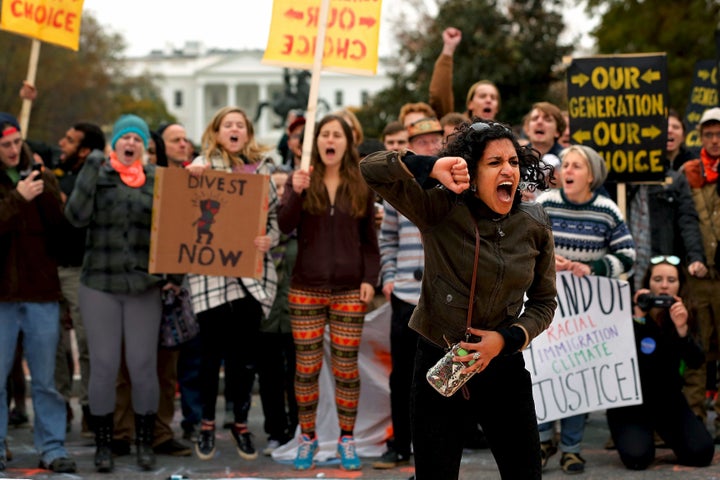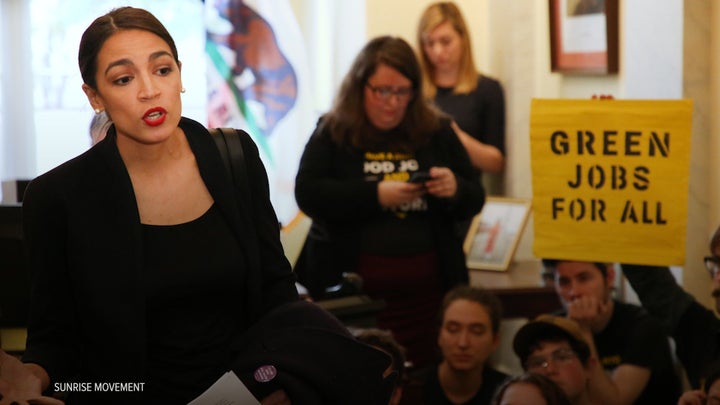The Green New Dealers are taking their movement on the road.
It’s been a whirlwind two months since the youth activists of the Sunrise Movement staged protests in Democratic leaders’ offices, bringing into the mainstream calls for a Green New Deal ― a sweeping federal policy that would mandate 100 percent renewable energy and provide good-paying sustainable jobs to millions of Americans.
Now the Sunrise Movement, likely the nation’s fastest-growing climate advocacy group, is planning a 14-stop tour meant to drum up grassroots support for a Green New Deal across multiple states, HuffPost has learned. It’s the first leg of the group’s effort to make the policy the defining issue of the 2020 election.
“We’re launching the Road to a Green New Deal Tour to activate the millions of Americans who are ready to fight for a Green New Deal but haven’t heard of it yet,” Varshini Prakash, co-founder of Sunrise Movement, said by email. “When you come out to a tour stop, we’ll give you all the tools you need to spread the word within your own community, build support, and pressure your elected officials to take a stand.”
In March and April, the Sunrise Movement will host events in Florida, California, Pennsylvania, New York, Kentucky, Michigan and elsewhere. The tour builds off an intensive new online training program, where volunteers are coached via webinars on how to confront politicians and frame an issue as overwhelming as global warming in terms of clear, effective action. Each event will include in-person training sessions, and conclude with organizing meetings for new converts.
“The goal of the tour is to invite tens of thousands of young people into the movement,” Stephen O’Hanlon, a spokesman for Sunrise Movement, said by phone. “We want to go where they are, and one thing we’ve learned … is young people across the country, in red states, blue states and purple states, are excited about what a Green New Deal could mean for their communities.”

The Sunrise Movement has added more than 100 new local chapters since November. That includes one in Wyoming, the nation’s top coal-producing state, two in Nebraska, a hotbed of pipeline battles, and another two in deep-red Utah. The group has raised more than $500,000 in just two months, with 650 new recurring monthly donors.
Founded officially in April 2017, the Sunrise Movement traces its roots back to the start of the decade, when the Occupy Wall Street protests put a national spotlight on the widening income gap. By the mid-2010s, the student activists who would go on to found the Sunrise Movement were leading efforts to pressure their universities to divest from fossil fuels. Drawing on lessons from the 2016 presidential bid of Sen. Bernie Sanders (I-Vt.), the group finally took form a few months after President Donald Trump began a full-on assault on environmental regulations in a push to bolster the oil and gas industry.
By the time the midterm elections began, the Sunrise Movement had started carving out a place for itself, helping to elevate candidates who took climate change more seriously than just declaring a belief in the basic science. The group helped run a ground campaign for left-wing candidates like Rep. Alexandria Ocasio-Cortez (D-N.Y.) and Michigan gubernatorial hopeful Abdul El-Sayed. The Sunrise Movement also bird-dogged powerful incumbents like New York Gov. Andrew Cuomo, who was forced to make an embarrassing public reversal after a teenage activist got him to promise to stop taking fossil fuel money on camera.
But the breakthrough came in November, days after the election.
Historic wildfires in California, buttressed by back-to-back United Nations and federal reports on the extent of human-caused global warming, generated an unusual amount of attention on the climate crisis. Then Democratic leaders made clear that climate change would be, at best, a midlevel priority after retaking the House of Representatives, with Nancy Pelosi, not yet the next House speaker, making the restoration of a decade-old select committee on global warming the cornerstone of the party’s strategy. In response, the Sunrise Movement staged sit-in protests in Pelosi’s office demanding Democrats instead champion a Green New Deal.
Ocasio-Cortez joined the protests, adding the political star power needed to grab headlines in a competitive, fast-moving news cycle. The 29-year-old socialist darling from New York also proposed a resolution to establish a select committee on a Green New Deal in the House, providing a counteroffer to Pelosi’s panel.
“Young people across the country, in red states, blue states and purple states, are excited about what a Green New Deal could mean for their communities.”
- Stephen O'Hanlon , Sunrise Movement
Nearly 40 House Democrats and a handful of senators backed the resolution. More than half the Democrats expected to run for president in 2020 slowly endorsed a Green New Deal in some form or another. One poll pegged the number of registered voters who support a Green New Deal at 81 percent, including 57 percent of conservative Republicans.
Pelosi and her allies kiboshed the effort last month, announcing plans to move ahead with the original select committee. But the push succeeded in making a Green New Deal a rallying cry.
Touring the country could build a grassroots base for eventual Green New Deal legislation that the last major federal climate bill ― the 2009 cap-and-trade proposal known as the Waxman-Markey bill ― never received.
“The politics have drastically changed since then,” R.L. Miller, the president of the political action committee Climate Hawks Vote, said by email. “Sunrise is a grassroots-driven group, unlike some of the top-down green groups pushing Waxman-Markey, and they have both energy and moral clarity on their side.”
But passion and urgent messaging only go so far, and the Sunrise Movement faces considerable challenges. Labor unions, a necessary constituency for a policy that essentially amounts to an industrial plan, are skeptical of proposals to end fossil fuel use, a source of lucrative contract jobs. The Sunrise Movement’s meteoric ascent was fueled by aggressive protests against potential Green New Deal champions, which risked “burning allies,” according to E&E News. In a competition with immigration, health care and taxes, climate change remains an underdog issue with relatively few vocal champions on the national level despite its ubiquitous threat.
Plus, the Trump administration is stacked at every level with officials who reject the very reality that burning fossil fuels is the primary cause of global warming, making it hard to envision Green New Deal legislation passing until 2021 at the earliest.
Other climate groups have taken different approaches.
The Citizens’ Climate Lobby built a network of roughly 400 local groups in part by pushing an avowedly bipartisan message on climate change and appealing to a small cadre of Republicans who back a moderate carbon fee-and-dividend policy. Despite its ideological malleability, many say such a policy amounts to a half-measure in dealing with greenhouse gases.
The Sierra Club’s Beyond Coal campaign empowered local communities across the country to organize around shutting down coal-fired power plants, but it’s limited in scope. The organization’s broader 100 percent renewable energy effort struggled until the emergence of the Green New Deal rhetoric to address concerns over the impact on jobs.
The Environmental Voter Project went the wonk’s route, using data to target specific voters it deemed likely to support green causes with aggressive get-out-the-vote materials. But it has a narrow focus, both in geography and mission.

“The challenge is how to scale it and make it sustainable,” Anthony Leiserowitz, the director of the Yale Program on Climate Change Communication, said of the upcoming Sunrise Movement tour. “One-off rallies in a few cities, for example, might generate a little press and get some temporary action, but the effects are unlikely to last or build sustained support for the policy or, I would argue, build the deeper political power of the climate movement.”
A series of local events might make for a flashy start to the year, but the Sunrise Movement’s 2020 election push won’t end with the monthlong roadshow. The group plans to confront presidential candidates directly, forcing each of the Democratic hopefuls to take a position on the Green New Deal and on whether to accept donations from the fossil fuel industry. It’s also preparing to stage protests at as many Democratic debates as possible ahead of the Democratic National Convention in July 2020.
The Sunrise Movement is working with electoral groups such as Justice Democrats and Climate Hawks Vote to identify progressive primary challengers to moderate incumbents who oppose a Green New Deal. Early polling already shows the group could make a difference. Democratic voters in New York’s 4th Congressional District, a densely populated swath of suburban Long Island, said they would support a primary challenger to popular Rep. Kathleen Rice (D-N.Y.) if she voted against a Green New Deal, according to survey data released last week.
“I feel the Sunrise Movement and their proposed Green New Deal is a genuinely exciting new development,” Ed Maibach, a climate communications researcher at George Mason University, said by email. “If the folks in the Sunrise Movement get out there and sell their idea to Americans before their opponents attempt to shoot it down, 2019 may prove to be an unexpectedly auspicious moment for climate solutions in America.”

